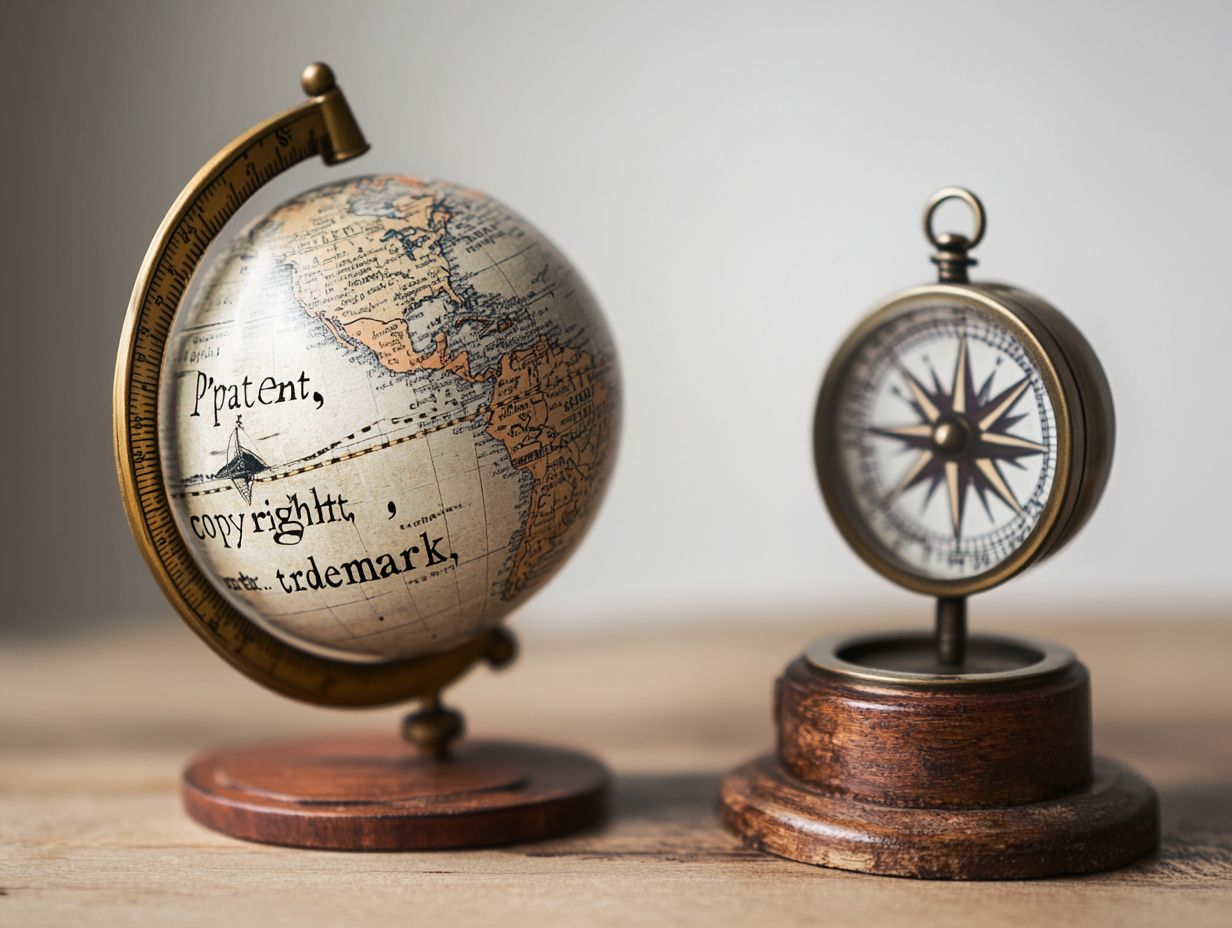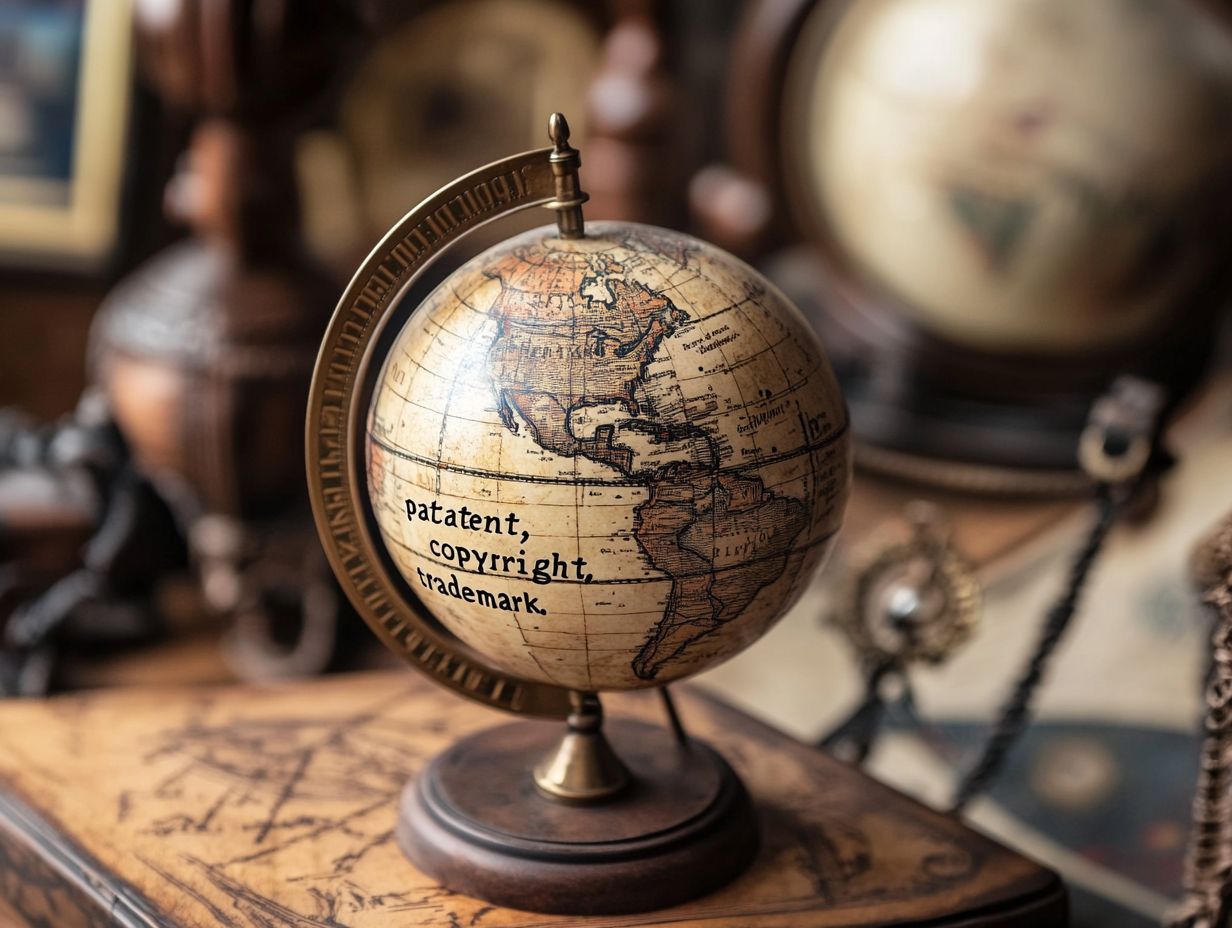How to Navigate International IP Treaties?
Navigating the intricate landscape of international intellectual property (IP) treaties can feel overwhelming for businesses and creators alike.
Grasping the definition and purpose of these agreements is essential, as they play a crucial role in protecting innovations and creativity across borders. Let s explore the key international IP treaties that can protect your ideas in the global marketplace!
This article examines the benefits of these treaties and offers practical steps for compliance while tackling common challenges and highlighting emerging trends that could influence the future of IP protection.
Dive in to uncover the essentials of international IP treaties and equip yourself to make informed decisions in securing your intellectual assets.
Contents
- Key Takeaways:
- Understanding International IP Treaties
- Key International IP Treaties
- Benefits of International IP Treaties
- Navigating International IP Treaties
- Steps to Take for Compliance
- Common Challenges and Solutions
- Addressing Conflicts and Limitations
- Future of International IP Treaties
- Frequently Asked Questions
- What are international IP treaties?
- Why is it important to navigate international IP treaties?
- How can I navigate international IP treaties?
- What are some potential challenges when navigating international IP treaties?
- What are some tips for navigating international IP treaties effectively?
- What are the consequences of not navigating international IP treaties properly?
Key Takeaways:

- International IP treaties provide legal frameworks for protecting intellectual property rights across borders.
- Benefits include easier market access and increased protection for businesses and creators.
- International treaties promote greater cooperation among countries.
- To navigate international IP treaties, stay informed, seek legal counsel, and ensure compliance.
Understanding International IP Treaties
International IP treaties are vital legal instruments that protect and enforce intellectual property rights (IPR) across diverse jurisdictions. They foster collaboration among nations, as highlighted in the article on understanding the role of IP in international trade agreements, to safeguard innovations, creations, and brands.
Treaties like the TRIPS Agreement, the Berne Convention, and the Patent Cooperation Treaty harmonize laws and offer consistent protections for creators and businesses alike, ultimately nurturing a more integrated global market.
These treaties also provide frameworks for international compliance, allowing countries to align with common standards while respecting their local laws and regulations.
Definition and Purpose
International IP treaties are designed to protect and enforce intellectual property rights (IPR) on a global scale. They ensure that you, as a creator, receive both recognition and financial rewards for your innovations.
These treaties do more than just protect your rights; they foster international cooperation and provide a structured approach to compliance with IPR laws across various jurisdictions.
By establishing common standards and practices, these treaties enable the cross-border exchange of ideas and products, which is vital for your creative industries. They cultivate fair competition in the marketplace while protecting the interests of inventors and artists like you.
This mutual respect for IPR encourages creativity and enhances trade, as countries are more inclined to invest in relationships when they know their intellectual contributions will be secure.
In this way, international IP treaties are instrumental in shaping a global economy that prioritizes originality and integrity.
Key International IP Treaties
Several key international IP treaties are crucial in shaping the landscape of intellectual property protection, as detailed in the comprehensive guide to understanding international IP law that you navigate.
The TRIPS Agreement establishes minimum standards for patent protection and other intellectual property rights among WTO members, setting the groundwork for global protections.
The Budapest Treaty enhances the global patent system by creating an international depositary authority for biological materials, ensuring that you can protect your innovations effectively.
The Madrid Protocol simplifies the trademark application process across member countries, allowing you to obtain cost-effective protection for your brand with ease.
Likewise, the Hague Agreement offers a comprehensive framework for the international registration of industrial designs, promoting global creativity and innovation in your endeavors.
For personalized advice on IP protection, consider consulting a legal expert.
Overview of Major Treaties
Major international treaties, such as the TRIPS Agreement, Berne Convention, and Patent Cooperation Treaty, are foundational pillars in the expansive landscape of intellectual property protection. They provide crucial guidelines for compliance and enforcement that member nations must uphold.
These treaties establish a common framework designed to harmonize intellectual property laws. This ensures that you deserve to protect your rights effectively across borders.
Take the TRIPS Agreement, for instance. It sets minimum standards for intellectual property protection, balancing the interests of rights holders and the public.
The Berne Convention underscores the importance of copyright, affirming that authors retain their rights. This nurtures creativity and fosters cultural exchange.
Meanwhile, the Patent Cooperation Treaty simplifies the process of securing patents in multiple jurisdictions. This makes it more manageable for you to navigate the complex global patent system.
Together, these treaties enhance international cooperation and compliance. They underscore the vital role of intellectual property protection as a catalyst for innovation and economic growth.
Benefits of International IP Treaties

International IP treaties present a wealth of advantages for you as a business or creator. They establish a solid framework for patent protection and trademark application, translating into substantial, cost-effective safeguarding of your intellectual property assets.
These treaties also open doors to licensing opportunities and bolster your competitive edge in global markets. They refine your strategic IP management practices.
By guiding you through the intricacies of international compliance, they protect your innovations and foster business growth. Additionally, they enhance market surveillance against digital infringement and trade secrets.
Advantages for Businesses and Creators
The advantages of international IP treaties for you as a business owner or creator are significant. They foster growth and provide a competitive edge in the marketplace.
These treaties safeguard your intellectual property rights while cultivating an environment ripe for innovation. You can effectively manage and capitalize on your IP.
By establishing standardized rules for protecting innovations and creative works across borders, these agreements help reduce the risks tied to foreign investments. You can confidently explore new markets, knowing that your patent rights and trademark protections will be recognized internationally.
Such treaties also promote collaboration among entities, assuring you that your innovations won’t be easily replicated without your consent. This spirit of collaboration paves the way for joint ventures and partnerships that propel further advancements.
Ultimately, this strengthens your market position and drives economic growth.
Navigating international IP treaties requires a comprehensive understanding of compliance requirements and the potential implications for businesses operating across various jurisdictions, especially when considering how to protect your IP internationally.
It’s essential for you to conduct thorough IP audits to evaluate your existing IP portfolio management. Ensure adherence to relevant treaties, including the Patent Cooperation Treaty and the Madrid Protocol.
This meticulous process involves understanding the enforcement mechanisms these treaties establish. It also ensures regulatory compliance to mitigate risks associated with digital rights management and potential legal disputes.
Now is the time to understand these treaties to safeguard your innovations effectively!
Steps to Take for Compliance
To ensure compliance with international Intellectual Property (IP) treaties, you should implement strong plans that include a thorough understanding of applicable treaties. Conduct regular IP audits and adapt your management practices accordingly.
This proactive approach allows you to meet regulatory requirements and leverage these treaties for strategic advantages. Start by identifying the specific treaties relevant to your operations. Remember that these can vary depending on your industry and geographical presence.
Once that’s established, organize educational training sessions to familiarize your employees with these regulations. Ensure they understand their roles in achieving compliance.
Integrate compliance monitoring software for real-time insights into any deviations from your established practices. By continually assessing and refining your strategies based on the latest international standards, you can cultivate a culture of compliance that protects your intellectual property and enhances your competitive positioning in the global market.
Common Challenges and Solutions
In the intricate landscape of international IP treaties, you may face several challenges, such as conflicts between national laws, limitations in enforcement mechanisms, and the rising tide of digital infringement. These challenges complicate the safeguarding of intellectual property rights.
To navigate these hurdles effectively, adopt strong dispute resolution strategies and leverage technological measures tailored to protect your innovations.
By diving into the nuances of treaties like the Berne Convention and the TRIPS Agreement, you can maneuver through the complexities of international compliance. For insights on future developments, check out international IP law: what’s next? This ensures your organization remains resilient and well-protected.
Addressing Conflicts and Limitations

Addressing conflicts and limitations in international IP treaties requires a multifaceted approach. This includes understanding the specific legal frameworks across various jurisdictions and the international obligations imposed by treaties like the TRIPS Agreement.
Act now to identify potential conflicts and craft strategies to mitigate their impact. This ensures you can effectively enforce your IP rights.
One effective strategy is to establish a comprehensive compliance program that educates your employees about intellectual property rights. Clearly outline the processes for reporting infringements.
Leveraging technology-driven tools can streamline monitoring of your IP assets, enabling you to detect unauthorized use swiftly.
Collaborate with local legal experts for invaluable insights into regional regulations. This helps ensure adherence to best practices in IP enforcement. Additionally, foster strategic partnerships with other firms to enhance your collective defenses against infringement. Cultivating a culture of shared responsibility ultimately strengthens your overall compliance.
Future of International IP Treaties
The future of international IP treaties stands on the brink of transformation. Emerging trends and technological advancements continuously reshape the landscape of intellectual property rights.
As globalization and digitalization advance, expect these treaties to evolve. They will address the challenges posed by nontraditional marks and digital rights management, ensuring robust protection mechanisms for creators and businesses alike.
Anticipated changes in treaties such as the Hague Agreement and Trademark Law Treaty will further align the global patent system with the demands of today s innovative economy.
Emerging Trends and Changes
New trends in international IP treaties highlight the need to update laws for the digital age.
As you protect new types of brands and navigate complex global rules, treaties like the Madrid Protocol may see significant changes.
This shift requires lawmakers to rethink how we govern intellectual property as technology evolves.
For instance, AI-generated content challenges traditional copyright definitions and leads to discussions about new legal protections.
With data privacy becoming crucial, treaties must include stronger measures to protect personal information online.
Countries are increasingly collaborating, and public awareness of IP rights is rising, driving a push for stronger, adaptable frameworks to meet these new challenges.
Frequently Asked Questions
What are international IP treaties?
International IP treaties are agreements between countries that establish rules and standards for protecting and using intellectual property (IP) rights, such as patents, copyrights, and trademarks.

Navigating international IP treaties is important because it helps individuals and businesses understand and comply with the legal requirements for protecting their intellectual property in different countries. This knowledge is vital for navigating IP law across borders, expanding their business globally, and avoiding legal issues.
To navigate international IP treaties, first understand the specific treaties that apply to your type of intellectual property and the countries where you want to do business. Then, consider navigating international IP strategies by seeking guidance from legal experts or using online resources provided by organizations like the World Intellectual Property Organization (WIPO).
Some challenges include differences in laws and regulations between countries, language barriers, and varying enforcement levels of intellectual property rights.
Helpful tips include thoroughly researching the treaties and laws applicable to your IP rights, seeking legal advice when necessary, and staying updated on any changes or updates in the treaties.
Not navigating international IP treaties properly can lead to the loss of protection for your intellectual property, legal disputes with other parties, and potential financial losses. Understanding the basics of international IP law and following the rules outlined in these treaties is crucial to avoid negative consequences.
Stay informed about IP treaties your creativity deserves protection!






